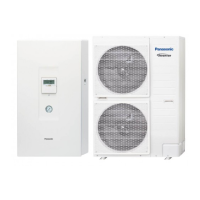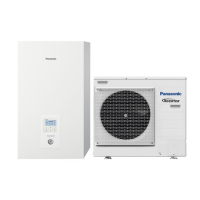Project Design
Hydraulics
Hydraulic integration
In individual cases, one or more water circulation pumps may be needed
for the respective heating circuits in addition to the device-internal water
circulation pump. If this is the case, the heat pump circuit and the heat
emitter circuit must be hydraulically decoupled via a buffer tank or a
hydraulic switch (low loss header). When integrating without hydraulic
decoupling, it must be ensured that the minimum circulation specied for
the respective heat pump (see technical data) is maintained at all times.
Automatic mixers or thermostatic valves can restrict the hot water circu-
lation to such an extent that the ow falls below the minimum circulation.
To prevent this, Panasonic recommends always combining heat transfer
systems without hydraulic decoupling with an auto-bypass valve
between the heating supply ow and return ow. The auto-bypass
valve must be designed for the nominal volume circulation of the
respective heat pump.
In contrast to standard pumps, high-efciency pumps with differential
pressure control have an independent controller. If the resistance in the
heating circuit increases, e.g. because thermostatic valves close, the
high efciency pump detects an increased differential pressure and auto-
matically reduces the speed and volume ow. That ensures that the
water circulation pump does not consume electricity unnecessarily.
The pump supplies the heat transfer system with a lower volume ow
until the valves re-open and the speed increases automatically due to
the decreasing differential pressure until the nominal volume ow or
the target differential pressure is reached.
The high-efciency pumps with differential pressure control used in
the Aquarea heat pumps have two control modes that can be set at
the pump.
Hydraulic decoupling
for standard pumps and
high-efciency pumps
without differential
pressure control
Hydraulic decoupling
for high-efciency pumps
with differential pressure
control
Q [l / min]
Δ p-v – variable differential pressure:
The electronic system changes the differential pressure target to be
maintained by the pump (congurable between levels 2 to 6), whereby
the differential pressure decreases simultaneously with the volume ow
to max. half of the differential pressure target.
Δ p-c – constant differential pressure:
The electronic system holds the differential pressure target to be
maintained by the pump at the value set (level 1 to 7) up to the
maximum point. Panasonic recommends this type of control.

